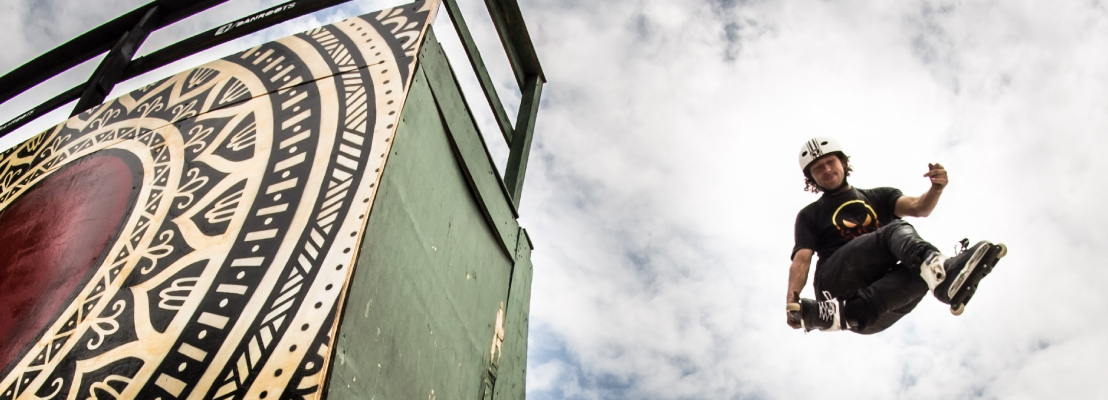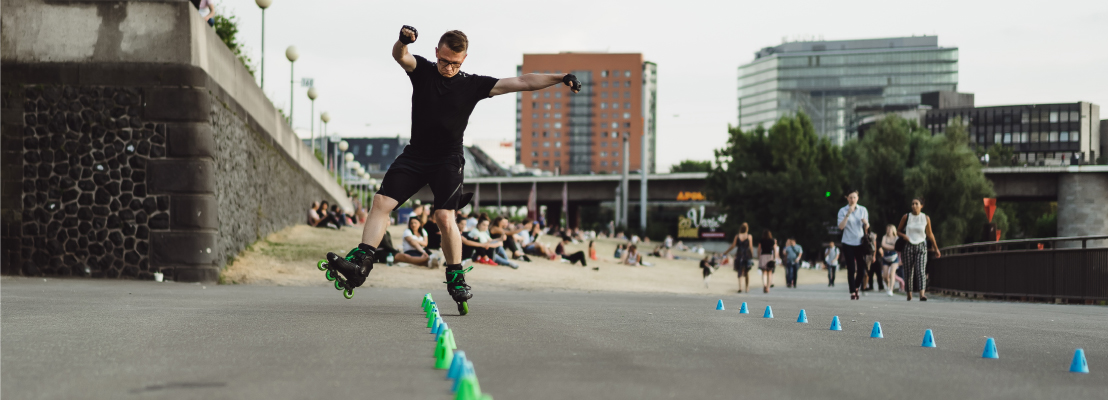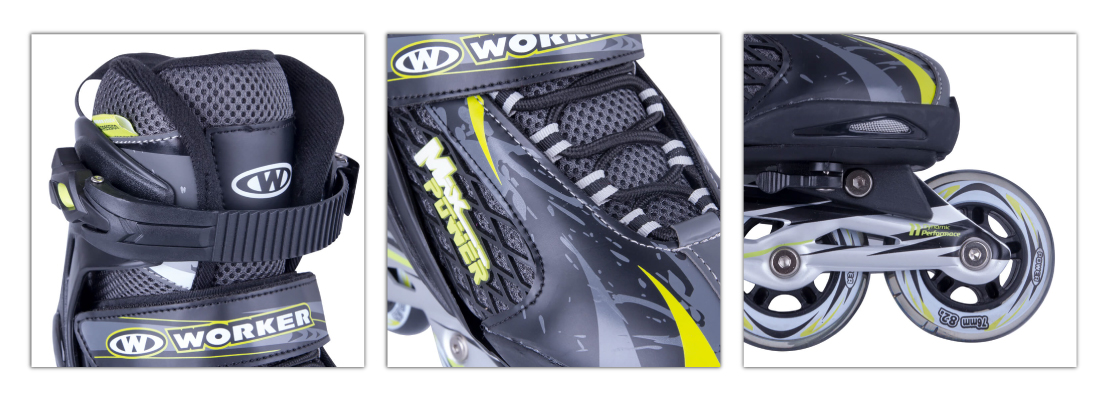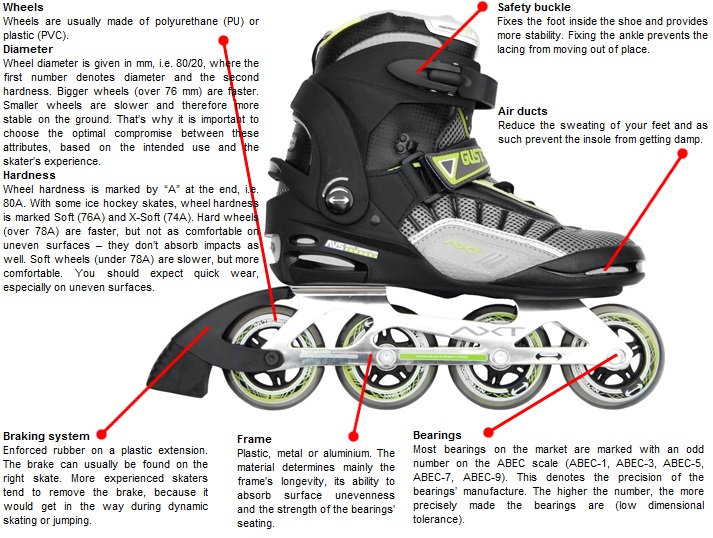How to Choose Children's Skates?
If you are picking out children’s skates – inline, ice or 2in1 – always prioritize quality. Choose rigid shoes with padding and adjustable size so that the skates...
6. 2. 2017
Compared products
Do you want to buy new inline skates, but are not sure which size and type to choose? We’ve prepared this detailed guide to help you.

Inline skating has become a hit in the last couple of years. However, before you purchase new inline skates, you need to think about how you intend to use them. Inline skating is a perfect way to relax while exercising, be it recreationally or professionally. Incline skates are suitable for number of activities and it’s only up to you to pick one.
When picking out inline skates, we consider:

It all depends on whether you are an experienced skater and know what type of skates you enjoy the most or whether you are a beginner with no defined style yet. It is also important to take into consideration the surface you will skate on most often. With these requirements in mind, you can choose the type of your new skates.
Fitness inline skates
These skates are the most widely used. Fitness inline skates are designed for fitness and recreational skating. They are easy to control, with comfortable and well ventilated shoes.
Aggressive inline skates
This type of skates is used mainly by skaters who like to perform tricks. They are designed for street skating, skate parks or skating over obstacles. Aggressive inline skates are easy to control and have several safety features. They are designed to endure extreme load during jumps, grands or slides. The majority of aggressive inline skates are UFS compatible (Universal Frame System), which allows you to buy parts from other manufacturers.

Speed (racing) inline skates
Performance-focused inline skates are suitable for racing and intensive training. They are designed for frequent use and higher load. Speed inline skates often come with a prolonged frame that is affixed to ankle-high shoes and may hold up to 5 wheels. They are suitable mainly for experienced skaters and professionals.
Slalom inline skates
These skates usually have smaller wheels placed close together. They are ideal for slalom skating. Slalom inline skates are suitable for intermediate and advanced skaters that plan on skating on quality surfaces.

Children's inline skates
The great advantage of some types of children’s skates is their adjustable size (adjustable tip, sometimes heel), ensuring the comfort of the young skaters. When choosing frame material, bearings type and wheel size, it is important to consider the probable intensity and style of the child’s skating.

Wheels are one of the most important factors influencing the skates’ effectiveness. Wheel size is marked in mm on the side of the wheel, i.e. 80/20, where the first number denotes diameter and the second hardness. Bigger wheels are faster and suitable for uneven surfaces. On the other hand, smaller wheels are slower and suitable for more quality surfaces. They are also easier to control.
Three vs. four wheel skates
➜ Inline skates with 4 wheels are clearly more common, because they are more stable and better suited to complete beginners and recreational skaters. On the other hand, it is necessary to use wheels of smaller size, which reduces the speed of the skate.
➜ Nn the other hand, inline skates with 3 wheels, are perfect for speed. You have the option to use the maximum wheel size of up to 125 mm and thus embark on an aggressive ride. However, this arrangement does not ensure such high stability and is especially suitable for advanced skaters. Bigger wheels also increase the price of the skates.
Wheel size and designation table
| Speed | Wheel size | Skating ability |
| Slower | 76 - 80 mm | Slower wheels are more suitable for beginners that are learning to keep balance and don’t need to be going fast. |
| Average speed | 81 - 84 mm | Average-speed wheels are suitable for almost all users of varying experience. |
| Fast | over 85 mm | Wheels over 90 mm big are very fast and suitable for experienced skaters (speed inline skates). |
| Children | 60 - 70 mm | For better safety, smaller wheels are used in children’s skates. They are not very fast and will help your child learn basic skating technique and how to maintain balance. |
For skating on U-ramps and in skate parks, smaller wheels are the best, providing you with better control while freestyle skating. (55 – 62 mm).
Durometer is a device that measures relative hardness, often tested with plastic and rubber products. There are several hardness scales – an “A” scale is used for wheels (i.e. wheels marked 78A). The number preceding the letter “A” is always in the range of 0 – 100, where 0 is minimal hardness and 100 is very hard material. Choosing the right hardness is not as easy as it may seem. Generally, you can follow the basic table below:
| 72A, 78A, 82A, 85A | ||
| Average service life | --------------------------- | Longest service life |
| High manoeuvrability | --------------------------- | Average manoeuvrability |
| High reflectance | --------------------------- | Average reflectance |
| Low body weight | --------------------------- | High body weight |
| Smooth ride | --------------------------- | Rough ride |

Wheel hardness and designation table
| Hardness | Marking | Fitness skating level |
| Softer | under 80A | Soft wheels are suitable for skating in rougher terrain, they are better for absorbing impacts. |
| Average hardness | 80A - 90A | Optimal hardness, for skating on regular surfaces, such as roads or inline skate tracks (fitness inline skates). |
| Hard | over 90A | Hard wheels are suitable for faster skating (speed, racing). |
Hard wheels are more suitable for skating on U-ramps and in skate parks, because of their longer service life and the probability of wear.

The shoe must provide maximum stability for the foot and ankle. There are usually two parts – the shell (wrapped around the foot) and the support (wrapped around the ankle). They are usually made of variably enforced plastic with air ducts for higher comfort while skating.
Choose appropriate size according to this size table:
| US | UK | EUR | Length (mm) |
| 5 | 4 | 36,5 | 230 |
| 5,5 | 4,5 | 37 | 235 |
| 6 | 5 | 38 | 240 |
| 6,5 | 5,5 | 38,5 | 245 |
| 7 | 6 | 39 | 250 |
| 7,5 | 6,5 | 40 | 255 |
| 8 | 7 | 40,5 | 260 |
| 8,5 | 7,5 | 41 | 265 |
| 9 | 8 | 42 | 270 |
| 9,5 | 8,5 | 42,5 | 275 |
| 10 | 9 | 43 | 280 |
| 10,5 | 9,5 | 44 | 285 |
| 11 | 10 | 44,5 | 290 |
| 11,5 | 10,5 | 45 | 295 |
| 12 | 11 | 45,5 | 300 |
| 12,5 | 11,5 | 46 | 305 |
| 13 | 12 | 47 | 310 |
| 13,5 | 12,5 | 47,5 | 315 |
| 14 | 13 | 48 | 320 |
| 14,5 | 13,5 | 48,5 | 325 |
| 15 | 14 | 49 | 330 |

The frame is another attribute influencing your skating style. A longer frame is suitable for endurance rides, a shorter frame allows you to better control the skates. The frame quality depends on what material it is made of – aluminium or plastic. Aluminium frames are more durable than plastic frames and can sustain bigger impacts.
Bearings influence both the speed and quality of your skating. Most bearings on the market are marked with an odd number on the ABEC scale (ABEC-1, ABEC-3, ABEC-5, ABEC-7, ABEC-9). This denotes the precision of the bearings’ manufacture. The higher the number, the more precisely made the bearings are (low dimensional tolerance).
Another thing to keep in mind is the way the frame is attached to the shoe. The more expensive models are affixed with screws, which will make cleaning them easier. Cheaper skates have frames affixed with rivets and the cheapest models are glued, or directly shaped as a part of the skate.

We are, of course, always concerned with your safety. Our wide selection of inline skates goes hand in hand with protectors and inline helmets that we’ve also prepared for you. You can purchase inline clothing as well. What’s more, we provide various skate parts and accessories separately, such as bearings, brakes, lights, etc.